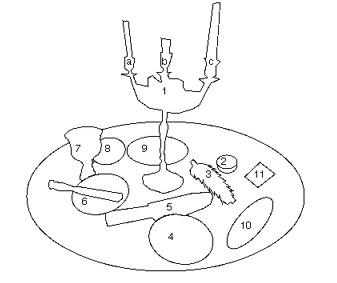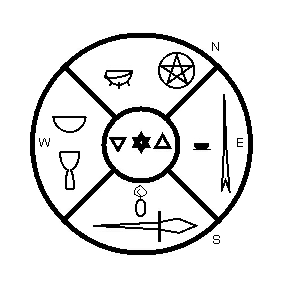 1. Center Piece
1. Center Piecea. Goddess
b. Center
c. God
2. Censer
3. Wand
4. Fire Candle
5. Athame
6. Bowl of Water
7. Chalice of Spirit
8. Cauldren of Salt
9. Pentacle of Cakes
10. Third Degree Cord
11. Lighter


Symbols only work when the people using them agree on what they mean.
The Braided Wheel Altar symbolically represents the cosmos, every time you set up the Altar you recreate the universe.
Altar Placement
Altar Table
Altar Cloth
Altar vs. Shrine
Center candle
Goddess Candle
God Candle
Center Piece
The Quarters
Air - The element of the East
Fire - The Element of the South
Water - The Element of the West
Earth - The Element of the North
Kitchen Witches
Outer limits
Pay attention to what you are doing. Everything on the altar should be there for a reason. Know the reason for each piece and the meaning for its placement.
 1. Center Piece
1. Center Piece
a. Goddess
b. Center
c. God
2. Censer
3. Wand
4. Fire Candle
5. Athame
6. Bowl of Water
7. Chalice of Spirit
8. Cauldren of Salt
9. Pentacle of Cakes
10. Third Degree Cord
11. Lighter
The tree, pole or pillar is a very ancient and powerful symbol for the entrance into the nonphysical realms.
The center three candles should be symmetrical; that is all three should be the same, or the candles of the God and Goddess the same, or all three should be different.
For example all three can be white, or the candles of the God and the Goddess can be white and the center candle black.
Here are some other (but not all) possibilities:
| God's candle | Center candle | Goddess's candles. |
| blue | purple | red |
| gold | black | silver |
| green | white | red |
To represent sunlight and moonlight I use metallic gold and silver respectively with black in the center to balance the light at the ends (black because white is too close to silver to balance it).
White and black are a common combination on two candle altars that emphasize duality. With red in the center black and white would balance for three candles. However, the combination of white, red, and black is usually associated with the three aspects of the Goddess (Maiden, Mother, and Crone respectively) and such a center setup might exclude the God completely.
Sometimes we use the fifth element called either Spirit or Ether. It can be called in the northeast at the point were Earth rejoins Spirit. It is sometimes called the fifth point of the star and in which case its color is white.
If you need to use a plant or bowl of seeds on your altar they go in the north east at the point between death in the Earth and rebirth in the Air.
 Each quarter of the Altar contains the tools, symbols and
other artifacts associated with that element. The tools are all
human creations, products of art and correspond to the Tarot suits. If you wish to work with the Tarot chose a deck that associates air with wands to avoid getting conflicting associations. The symbols are representatives of the elements and occur in nature. Any object can be classified according to its predominant element to find its proper place on the Altar. We sometimes make a game of trying to decide where various household items would go.
Each quarter of the Altar contains the tools, symbols and
other artifacts associated with that element. The tools are all
human creations, products of art and correspond to the Tarot suits. If you wish to work with the Tarot chose a deck that associates air with wands to avoid getting conflicting associations. The symbols are representatives of the elements and occur in nature. Any object can be classified according to its predominant element to find its proper place on the Altar. We sometimes make a game of trying to decide where various household items would go.
| Direction | Tool | Symbol |
| East | Wand | Incense |
| South | Athame | Candle |
| West | Cup of Spirit | Bowl of Water |
| North | Pentacle of Cakes | Cauldron of Salt |
Never haggle over the price of your ritual tools. Always pay what is asked.
Wands are traditionally made of wood, a once living material. The Wand bridges the gap between Earth and Air the way a tree joins Earth and Sky. Trees commune with Air and are destroyed by fire. A staff would be classed with the Wands as would pencils and pens. Quill pens have obvious air associations. The enmity between the fire of passion and the cool wind of intellect is as old as paper books and censorious bonfires. The cool wind of reason is destroyed by the hot flames of passion.
Many traditions consider the wand to be a tool of fire, as a result wands are frequently available as copper tubes packed with crystals and herbs.
An incense burner is kept in the east as the symbol of Air. Any excess incense is kept in the east-north-east, near the element of Earth. A lighter or a box of matches is kept handy to the east.
A bell for announcing the arrival of astral guests is kept in the east-south-east because sound is one of the attributes of Air.
Reference books can be stored in the east.
The Athame should be forged in fire, metal blades are the most common, glass is acceptable. The Blade is the reminder that every gain has a cost, every path that is taken leaves another path untaken, one thing must be destroyed for another to be created.
An Athame should have a black handle for receiving energy, but bone, horn or hoof handles are acceptable. To give a knife cuts the friendship. Never give a knife as a gift. Never receive a knife without giving something in return if only a penny. Swords and other bladed weapons go in the south.
"Every established kitchen has one ancient knife, its handle worn thin, its blade curved like a banana, and so inexplicably sharp that reaching into the drawer at night is like bobing for apples in a piranha tank" Terry Pratchett, Witches Abroad p220.A red candle is kept in the south as the symbol of Fire. If you cannot get red, orange is close as long as its not being used anywhere else.
A taper, loose candle, is kept in the south to light the other candles with. It should be white.
The snuffer is used to put out candles. I was taught that it insults the flame to blow it out. The snuffer is fire related so it is kept in the south.
It is important that the drink in the Chalice come from a once living source and alcoholic beverages are said to have "spirit".
A bowl of water is kept in the west as the symbol of Water. After the purification it will be salt water. The oceans were the first source of life on this planet and we still carry the reminder of that in our amniotic fluid and blood. Life can not exist without the ocean the only life could leave the ocean was to take the ocean with it. Our blood is a saline solution very close to sea water. The oceans are the womb of the Goddess.
A corkscrew and the rest of the bottle of wine or juice can go under the altar in the west. Any extra drink goes to the west.
The Earth is the source of our food, all wealth comes from the Earth, it is also the resting place of the dead. The dead and harvested grain is buried in the earth and rises to live again. Life feeds on life, for us to live others must die. We plant our dead in the earth that they too may be resurrected.
The cauldron of salt is kept in the north. It is the symbol of Earth. One of the legends of the Goddess Ceridwen's cauldron is that the bodies of the dead go into it and are brought back to life. It is usually crones and hags, death goddesses, that have cauldrons.
Any extra food goes at the north edge of the Circle.
"What might be called the classical witch comes in two basic varieties, the complicated and the simple, or, to put it another way, the ones that have a room full of regalia and the ones that don't. Magrat was by inclination one of the former sort. For example, take magical knives. She had a complete collection of magical knives, all with the appropriate colored handles and complicated runes all over them. It had taken many years under the tutelage of Granny Weatherwax for Magrat to learn that the common kitchen breadknife was better than the most ornate of magical knives. It could do all that the magical knife could do, plus you could also use it to cut bread". Terry Pratchett, Witches Abroad p220.In ceremonial traditions there are very formal rules about all the tools. Braided Wheel is more folk based than ceremonial.
By tradition a Wand should be the length of your forearm from your elbow to the tip of your longest finger. It should be made of wood and you should give a gift to the tree that gives you its branch.
The Athame in ceremonial tradition is a double edged knife. In the tradition of weapons a double edged knife is a stabbing weapon used primarily by assassins. In the Braided Wheel tradition a single edged kitchen knife is considered more appropriate. The ceremonial tradition also forbids using an Athame to actually cut anything. This rule protects the magical device from being contaminated by earthly matter. Because we are an Earth centered tradition we consider using the athame to cut things reinforces its cutting nature.
The Chalice is a cup of plenty. It is the archetype behind the trophy cup and the wedding cup. The chalice is related to the caldron in germanic tradition. At a feast there would be one caldron of drink and one of boiled meat.
The Pentacle is the platter. It holds abundance.
In practice it is nice to have formal tools with mystical symbols engraved all over them, but in a pinch any stick can be a wand, any knife can be an athame, any cup can be a chalice, and any flat rock or paper plate can be a pentacle.
The East candle should be yellow, the color for Air. The South candle should be red, the color for Fire. The West candle should be blue, the color for Water. The North candle should be green, the color for Earth. The quarter candles should be in the colors of their quarters or all in a neutral color like white.
Watch your correspondences. If any of your center candles are the same color as your quarter candles check your altar for overall balance.
Keep in mind that this is only one way to set up an altar. There are many types of altars and all are equally valid.
Outdoor rituals usually have a bonfire at the center and a much more informal altar off to one side. When we are surrounded by nature it takes fewer tools to make the connections. Stay flexible to the opportunities that nature presents. And if it all looks to intimidating or if you have a great need and few resources just remember the words of Granny Weatherwax:
"You don't need none of that," she said. "You need headology...You just use whatever you've got." Terry Pratchett, Wyrd Sisters p.90